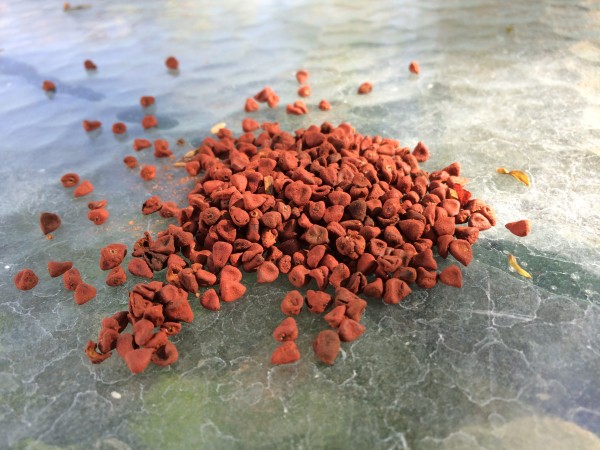Bixa orellana, better known by its common name, achiote, is a small evergreen shrub that produces pink flowers along with pods filled with red, pigmented seeds. According to BMC Complementary and Alternative Medicine, achiote has been used in Latin American folk medicine for hundreds of years. Achiote was thought to have medicinal properties, including serving as protection from ultraviolet radiation and microbes. Since achiote contains a large amount of carotenoids, it does indeed confer protection to one’s eyes from ultraviolet radiation! The article also discusses how the achiote leaf has antimicrobial activity against Bacillus cereus and most gram-positive bacteria (bacteria that have a thick cell wall composed of peptidoglycan). Scientists, in hopes of synthesizing new antibiotics, are investigating these results further. It is possible that in the near future, the achiote plant may contribute to better antibiotic medications than the ones available to us today.
Achiote seeds
Image source: Víctor Augusto Mendívil
According to American Heritage Dictionaries, achiote’s vibrant pigmentation made it a popular ingredient in many cosmetic and culinary products made by the indigenous people of the Americas. The achiote plant is nicknamed “the lipstick tree” because, as you may have guessed, its pigment was and still serves as the source for lipstick.
Achiote does not contribute flavor to the foods it is incorporated into, but rather supplies its distinctive, vivacious coloring. Achiote is still widely used in Latin cuisine. One can find achiote in dishes such as: mole, achiote chicken, rice, and sofrito. The Food and Drug Administration lists achiote as one of the main sources for natural red food colorant – it is used to color popcorn, butter, and drinks.
Although the name may not sound familiar, the achiote plant’s pigment and antimicrobial properties are largely relevant to our everyday lives. The next time you open a bottle of red soft-drink or dab red lipstick on your lips for a night out, remember that the hue was all made possible by the remarkable achiote plant!
Featured image by Carolina Aparicio










